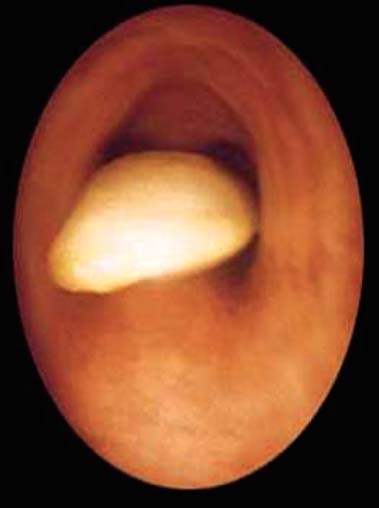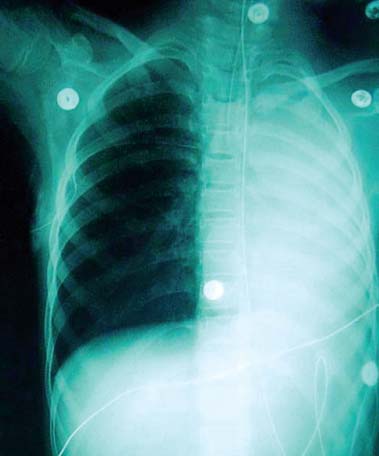36 Core Messages • Aspirated foreign bodies are a potentially fatal hazard to children. • Delayed diagnosis is common, and it increases the rate of complications. • Rigid bronchoscopy and removal is the treatment of choice in foreign-body aspiration, but role of flexible bronchoscopy is growing. • Many ingested foreign bodies can be managed expectantly. After 24 hours, it is often necessary to remove the object endoscopically. • Ingested batteries can be life-threatening and should always be removed expediently. Foreign body of the aerodigestive tract is a clinical problem that the otolaryngologist must be well equipped to handle. The clinician should have a high index of suspicion in patients with identifiable risk factors to make a prompt diagnosis. Delay in treatment can lead to considerable mortality and morbidity that can often be minimized with the prompt initiation of therapy. The clinical pathway and treatment strategy will vary somewhat with management, depending on the age of the patient and the location of the foreign body in either the airway or the esophagus. Foreign-body aspiration (FBA) should be suspected in all cases of witnessed or reported choking as well as in patients with respiratory or gastrointestinal symptoms that do not appropriately respond to conventional treatment. In 2001, FBA accounted for 17,547 emergency room visits for children younger than 14 years.1 The most common items aspirated in this series were candy/gum and coins. One hundred sixty children died from inhalation or aspiration of foreign body in 2001. Almost three quarters of pediatric FBAs occur in children younger than 3 years, and men appear to have a slightly increased prevalence.2 Children below 3 years of age have increasing development of fine motor skills and a proclivity for placing things into their mouths but have underdeveloped molars and smaller airways that are prone to obstruction.3 As the diameter of the airway continues to decrease, airway resistance increases exponentially. Furthermore, children have lower tidal volumes and decrease cough response, making it more difficult to expel aspirated foreign bodies. The most common objects aspirated by children younger than 3 years are food products, and the most common vary based on regional custom (e.g., peanuts in the Western society and watermelon seeds in the Middle East) (Fig. 36.1).4,5 Children over 5 years of age most commonly aspirate nonfood items, most frequently coins and school supplies.6 The most frequently involved object in fatal aspirations is the balloon.7 The ring of the balloon can form a tight seal in the airway, and any pressure within the airway serves to inflate the balloon rather than dislodge it. Other objects commonly involved in fatal aspiration are those that are round, compressible, and smooth and do not break apart easily. Most aspirated foreign bodies are found within the bronchi, with the right main bronchus accounting for approximately half of all locations.4 The left main bronchus accounts for approximately 20%, and the larynx and trachea account for portions between 3 and 13%. While laryngeal or tracheal foreign bodies are less common, they are associated with increased morbidity and mortality.8,9 Obstruction in these areas is typically associated with either large food products or patients with tracheal stenosis. FBA is much less common in adults than in children; however, adults older than 75 years have increased risk of mortality after FBA.10 While children are susceptible to FBA owing to a tendency to place objects in their mouths, older adults are more likely to suffer from a decrease in the ability to protect the airway. The most likely type of foreign body is variable and depends on the age and activity level of the patient. Middle-aged adults may aspirate nails or pins while holding them in their mouth during home maintenance activities. Dental appliances can be aspirated by patients with prostheses, and all patients with a history of neurologic disorder or alcohol and sedative abuse should be considered at increased risk for FBA.11 Figure 36.1 A peanut trapped within the airway. It is important to survey the entire airway after extraction for additional or residual foreign body. Foreign-body ingestion (FBI), like FBA, occurs much more commonly in children than in adults, with incidence being highest in children younger than 3 years.12 Death from FBI is extremely rare but is possible depending on the object ingested. Sharp objects such as bones and nails can cause esophageal hemorrhage, and button batteries can cause esophageal necrosis and perforation.13,14 Children have been reported to ingest all kinds of small objects, the most common of which are coins.15 Repeated FBI, however, is a problem typically associated with developmental delay.16 In adults, patients at highest risk are those with underlying esophageal pathology (e.g., carcinoma or stricture).17 In addition, patients with neurologic disability are at higher risk and prison inmates have a high incidence of intentional ingestion.18 The presentation of FBA is highly variable and depends on the age of the child, the location of the foreign body within the airway, the degree of obstruction, the type of object aspirated, and whether the event was witnessed. Children who present with cyanosis and respiratory distress require immediate airway management, rigid bronchoscopy for diagnosis and treatment, and supportive care. Patients with FBA with urgent clinical presentations will most often have a laryngotracheal foreign body with near-complete or complete airway obstruction.8,9 Patients that present with subacute symptoms or have had an unwitnessed aspiration require a higher index of suspicion. Reports may indicate generalized wheezing. It is important, however, for the clinician to meticulously repeat the physical examination, focusing on localized wheezing and decreased airflow confined to anatomic regions of the lung. The classic triad of FBA includes cough, wheeze, and diminished breath sounds. However, the clinician should be aware that this triad is present only in approximately two thirds of the patients.19 While the absence of the triad is not sensitive enough to rule out FBA, series data from 370 patients showed this triad to be 96 to 98% specific in children with FBA.20 Additional symptoms may vary in patients based on their location within the airway. Tracheal foreign bodies may result in stridor and dyspnea. Bronchial foreign bodies may cause shortness of breath, hemoptysis, and coughing in addition to the classic triad. A witnessed episode of choking has between 75 and 90% sensitivity in FBA.21,22 The episode may last anywhere from seconds to minutes and often resolves. The clinician should counsel caregivers that even though the acute event may appear to have resolved, FBA is still quite possible. The assumption that the episode is over can lead to delay in diagnosis, which may ultimately lead to pneumonia, lung compromise, or bronchiectasis, which may ultimately require surgical resection such as lobectomy or even pneumonectomy. Should a delay in diagnosis occur, patients often present with signs of airway inflammation and infection. They may have any combination of fever, recurrent pneumonia, wheezing, or chronic cough.23 FBA in adults is much less common than in pediatric populations, but adults may show atypical symptoms. Diagnosis is much more likely to be delayed in adults than in children, and less than half of adults will have shortness of breath or wheezing. Chronic cough was almost universally present in these patients, with other symptoms (hemoptysis, fever, and chest pain) being less common.24 Presentation of patients after FBI is often much less acute than with aspiration. Up to half of pediatric patients may show no signs or symptoms at all. If present, symptoms are often transient and may include chest pain, dysphagia, or indigestion.25 Patients may also complain of the feeling of something being stuck in their throat. Patients often present for medical care because parents or caretakers witnessed the ingestion.26 The paucity of symptoms often leads to a delay in diagnosis. Long-term consequences of FBI may include weight loss secondary to malnutrition or aspiration pneumonia owing to the inability to handle excess secretions.27 Acute presentations are related to sharp or caustic objects that cause esophageal perforation or erosion. This is a potentially life-threatening event that can present with fever, mediastinitis, and crepitus around the neck or upper chest. Adults with FBI most often complain of dysphagia, inability to handle secretions, and neck pain.28 The clinical history is the most important aspect in deciding whether to perform bronchoscopy in patients with suspected FBA. Bronchoscopy is the gold standard for diagnosis. Radiographs may be helpful but only when some degree of airway obstruction is present and when patients have aspirated or ingested radiopaque objects. In patients with foreign bodies of the larynx or trachea, posteroanterior and lateral neck films should be obtained, which may show swelling or density in the subglottis.8 Posteroanterior and lateral chest films should also be obtained, which may show mediastinal shift, obstructive emphysema, or atelectasis (Fig. 36.2).29 In cases of delayed diagnosis, infiltration and regional consolidation may be observed secondary to pneumonia. In addition, bronchiectasis may be observed when the foreign body has been present for a prolonged period of time. Added diagnostic yield may be obtained by obtaining inspiratory and expiratory films, which will indicate hyperinflation of affected lung segments. In uncooperative patients, lateral decubitus films can also be used, which will show hyperinflation on the affected side. Fluoroscopic evaluation has also been shown to have some benefit in the diagnosis, as it can be performed rapidly and does not require precise positioning of the patient for proper evaluation.30 The most important aspect to remember in using radiographic evaluation for suspected FBA is that imaging should not be obtained if clinical presentation of the patient is severe or has potential to quickly deteriorate. In patients with suspected FBI, posteroanterior and lateral neck, chest, and abdominal films should be obtained. Traditionally, objects located in the trachea will be oriented in the sagittal plane while objects in the esophagus will be oriented in the coronal plane. If films appear negative, the clinician should consider computed tomography imaging to locate the foreign body within the gastrointestinal tract. Barium studies can be dangerous in suspected perforation and can decrease the utility of endoscopic evaluation.31 In addition, the clinician should be aware that eosinophilic esophagitis can predispose patients to food impactions in the esophagus, and biopsies should be obtained at the time of removal, especially if the patient has normal neurological development.32
Foreign Bodies of the Aerodigestive Tract
Epidemiology
Airway Foreign Bodies
Foreign Body of the Esophagus
Presentation
Airway
Esophagus
Evaluation
< div class='tao-gold-member'>
Foreign Bodies of the Aerodigestive Tract
Only gold members can continue reading. Log In or Register to continue

Full access? Get Clinical Tree




